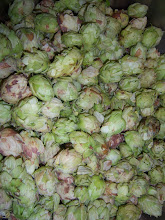This version of a British mild brown is from Steffan’s Aldergrove Brewery in Tulalip, WA. I’m guessing that Aldergrove is a fairly small brewery—their label looks about a half step up from
 being printed out on home computer. We found this at Bottleworks in Seattle.
being printed out on home computer. We found this at Bottleworks in Seattle.Brown Eyed Girl has a light malt nose with a slight estery smell; it smells—quite literally, in fact—like a light brown ale. While it is brown colored, it is very clear, and, keeping with the British style, has very light carbonation. It begins with almost no front; there is a slight light faint sweetness that moves into some brown sugar, nutty flavors, and light spiciness, and it finishes with low levels of bitterness and rather dry. Brown Eyed Girl has a light body and very low carbonation; both qualities contribute to making this beer rather thirst quenching and
 quaffable: with the low ABV, you could easily drink a whole boatload of this stuff, which is most certainly the point with a mild. Although there is something a bit cola-ish in the beer, a taste that does increase with warmth, it is nonetheless complex and interesting, even for such a light beer—the smooth rounded malt profile in the middle hits all the right notes. For our money, this is easily the best 115 calories you are going to find in a twelve ounce bottle. To quote M.C. Hammer: “Proper.”
quaffable: with the low ABV, you could easily drink a whole boatload of this stuff, which is most certainly the point with a mild. Although there is something a bit cola-ish in the beer, a taste that does increase with warmth, it is nonetheless complex and interesting, even for such a light beer—the smooth rounded malt profile in the middle hits all the right notes. For our money, this is easily the best 115 calories you are going to find in a twelve ounce bottle. To quote M.C. Hammer: “Proper.”From the Aldergrove website: “Brown Eyed Girl is a classic ‘session’ beer that is full-flavored yet low in alcohol and low in residual sugars. With hints of chocolate and caramel it is deceptively dark yet refreshingly light on the tongue. Hmmm, is this beverage conflicted or is it complex? Try it and tell us what you think. As beer styles go, the mild is one of the least well-known. At it’s height of popularity in the UK it outsold all other styles combined. However, since the Industrial Revolution many more different ales were springing up and taking their turns at the top of the hill. Stronger brown ales, porters, bitters and pale ales eventually pushed
 the small mildly flavored session beer out of popularity. Session beers have gotten short shrift in the modern marketplace. Steffan believes this has only to do with the legacy of Prohibition. Since Prohibition the few American breweries that survived had to compete for scarce raw materials to make beer in large part due to the war-time shortages arrising from WWI & WWII. The dumbing-down of American beer resulted in the pale fizzy tasteless beverage that soon came to dominate the world as the post-war economy expanded. Instead of returning to making more robust beers that were popular in the prior century, brewers used the lower costs and increased profits to attempt to gobble up more market share. This type of beverage was typically cheap and of very low alcohol content, another legacy of Prohibition. Many local jurisdictions in
the small mildly flavored session beer out of popularity. Session beers have gotten short shrift in the modern marketplace. Steffan believes this has only to do with the legacy of Prohibition. Since Prohibition the few American breweries that survived had to compete for scarce raw materials to make beer in large part due to the war-time shortages arrising from WWI & WWII. The dumbing-down of American beer resulted in the pale fizzy tasteless beverage that soon came to dominate the world as the post-war economy expanded. Instead of returning to making more robust beers that were popular in the prior century, brewers used the lower costs and increased profits to attempt to gobble up more market share. This type of beverage was typically cheap and of very low alcohol content, another legacy of Prohibition. Many local jurisdictions in  America by law restricted the alcohol content of beer to 3.2% by weight. In these locations the only beer that could be had legally was by definition a session beer. Once the craft beer revolution began in the 1970’s the pendulum swung very far to the stronger end on the alcohol spectrum. Now that stronger beers are more widely available the desire for stronger beers has begun to become satiated. Not everyone who likes full-flavored beers wants to get blotto after two pints. Enter the craft-brewed full-flavored session beer.”
America by law restricted the alcohol content of beer to 3.2% by weight. In these locations the only beer that could be had legally was by definition a session beer. Once the craft beer revolution began in the 1970’s the pendulum swung very far to the stronger end on the alcohol spectrum. Now that stronger beers are more widely available the desire for stronger beers has begun to become satiated. Not everyone who likes full-flavored beers wants to get blotto after two pints. Enter the craft-brewed full-flavored session beer.”ABV: 3%
Calories: 115
(11/27/2009)

No comments:
Post a Comment